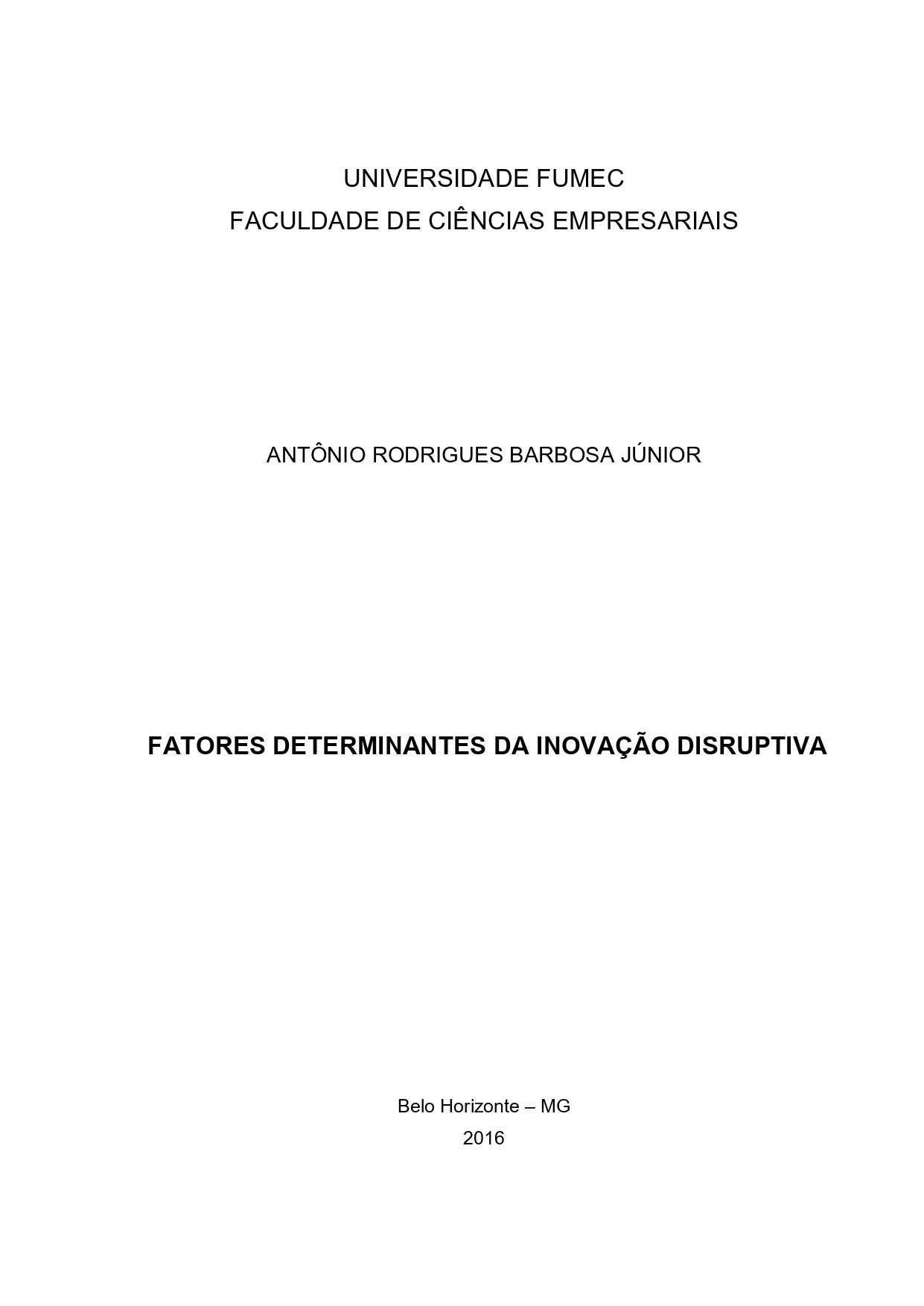Fatores determinantes da inovação disruptiva

Visualizar/
Data
2016Autor
Barbosa Junior, Antônio Rodrigues
xmlui.mirage2.itemSummaryView.MetaData
Mostrar registro completoResumo
Neste estudo, o objetivo central foi analisar como os fatores determinantes da inovação disruptiva lucrativa promovem inovações em empresas brasileiras. A ótica foi a de gestores das firmas. Para isso, efetuou-se pesquisa com 88 organizações e utilizou-se a modelagem de equações estruturais e a Análise Hierárquica de Agrupamento. As empresas respondentes são na maioria pequenas firmas inovadoras, relativamente emergentes. Entre os resultados do trabalho, tem-se que todos os fatores previstos para a inovação disruptiva lucrativa foram confirmados para o grupo pesquisado. O mercado mostra a maior quantidade de relações de influência. Os fatores externos influenciam mais pelas estruturas de ensino, via fornecimento de pessoal qualificado. Esse pessoal também foi verificado como um fator interno fundamental, em especial os empreendedores, mas o recurso mais importante consiste na cultura de inovação. Também foi confirmada a existência de organização flexível. As patentes podem ser necessárias, mas não imprescindíveis. Na ordem a seguir, todas as cinco estratégias tecnológicas/negociais foram implantadas pelas firmas consultadas: agregação de valor, exploração de novas aplicações, simplificação, mudança no modelo de negócio e miniaturização. Assim, as estratégias menos frequentes na literatura foram as mais utilizadas. Essas empresas buscaram o novo mercado (quem não adquiria aquele tipo de produto antes), o baixo mercado (segmentos com menor receita) e o mercado destacado (surge quando um produto atende muito bem a uma necessidade muito diferenciada). Produtos recentes dessas firmas apresentam potencial disruptivo, pois são mais convenientes, de menor custo, mais simples e/ou com menor tamanho. As políticas públicas foram consideradas desconectadas do processo de inovação. A atuação em rede dessas firmas com outras organizações acontece pouco. A apropriabilidade dos ganhos com os produtos inovadores tem sido vantajosa para a maioria das empresas pesquisadas. Quatro tipos de firma foram identificados: o lobo
solitário, o inovador engajado, o pouco inovador e o inovador mediano. Concluiu-se que os fatores centrais para a inovação disruptiva nessas empresas brasileiras são os fatores internos – em especial o pessoal qualificado e a cultura, o mercado e as estratégias tecnológicas/negociais. Os fatores externos são os mais deficientes, tanto pelo descolamento das políticas públicas quanto pela baixa utilização do
potencial científico das estruturas de ensino/pesquisa pelas empresas. Isso sugere que o dilema do inovador pode atingir todo o Sistema Brasileiro de Inovação, em vez de apenas as firmas. Além disso, essa deficiência compromete a atuação em rede e pode ser a responsável por essas empresas privilegiarem as estratégias tecnológicas menos usadas em outros países. Por conseguinte, as firmas
pesquisadas parecem se encontrar em um estágio intermediário do processo disruptivo. O diminuto grupo de empresas com melhores resultados na inovação disruptiva – o inovador engajado – mostra que todos os fatores, inclusive os externos e a atuação em rede, precisam ser explorados em sua plenitude. In this study, the main objective was to analyze how the determinants of profit disruptive innovation promote innovation in Brazilian companies. The Optical was the managers of firms. To achieve this goal, was made a research with 88 organizations and used the structural equation modeling and hierarchical cluster analysis. The respondent companies are most innovative small firms, relatively emerging. Among
the results of the work, all the factors provided for lucrative disruptive innovation have been confirmed for the studied group. The market shows the greatest amount of effect relationships. External factors influence over the education systems, through the supply of qualified personnel. This staff was also seen as a key internal factor, especially entrepreneurs, but the most important feature is the corporate culture of
innovation. The existence of flexible organization also was confirmed. Patents may be necessary but not essential. In the following exposed order, all five technological / negotiating strategies were implemented by the consulted firms: augmentation, exploitation for another application, simplification, change in the business model and miniaturization. Thus, the less common strategies in the literature have been frequently used. These companies sought new market (who did not acquired that type of product before), the fringe market (segments with lower income) and the detached-market (arises when a product meets very well to a very different need).Recent products of these firms have disruptive potential because they are more convenient, less expensive, simpler and / or in a smaller size. Public policies
were considered disconnected from the innovation process. The network performance of these firms with other organizations little indeed happens. The appropriability of gains with innovative products has been advantageous for most companies surveyed. Four types of firm have been identified: the lone wolf, the highly integrated-innovator, the slightly innovator and the moderately innovator. It was
concluded that the key factors for disruptive innovation in this set of Brazilian companies are the internal factors - especially qualified personnel and culture, the market and technology / business strategies. External factors are the most disabled, both the detachment of public policy and the low utilization of the scientific potential of education systems / research by companies. This suggests that the innovator's
dilemma can reach all the Brazilian System of Innovation, rather than just firms. Also, this deficiency compromises network performance and can be responsible for this corporate group favoring technological strategies used less in other countries. Therefore, the searched firms seem to meet at an intermediate stage of disruptive process. The small group of companies with the best results in disruptive innovation -
the highly integrated-innovative - shows that all factors, including the external and the network performance, need to be explored to its fullest.
